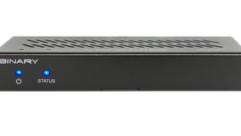How to distribute multiroom sound
Dec 1, 1997 12:00 PM,
Bob Heil
There are several methods of providing audio in various rooms of the house.Some get expensive and complicated, but for most applications a simple,high-quality audio feed is all that is necessary.
An audio distribution system is a low-level background music systemoriginating from a single source and feeding loudspeakers in various partsof the house. These are usually kitchen, garage, utility room, bathroom,den, library and dining room. An audio distribution system is not of thetype suitable for Madison Square Garden, nor is it a critical-listeningsystem for audiophile listening. There’s really no need for superhigh-fidelity stereo sound in these areas. Your client may not want remoteloudspeakers for bedrooms, but rather, completely independent systems. Thiswill be especially true of teenagers’ bedrooms.
Many of the audiovisual receivers produced today have what theirmanufacturers call multiroom/multisource functions. This usually allows thetwo rear-channel amplifiers, usually 10 W or 15 W each, to be switched outof Pro-Logic mode and used to drive the rest of the house. Not every readermay agree, but I believe strongly installers should not use thesefunctions. For one reason, consider this. One member of the family iswatching a full-bore theater presentation when another pops in a compactdisk. The theater sound system loses its rear channels suddenly, a verydiscombobulating experience. Another reason these channels seldom worksatisfactorily is that 10 W or 15 W is insufficient for most purposes. Howlong a wire can such power drive? How loudly will the remote loudspeakersplay? What impedance problems will you have powering multiple remoteloudspeakers?
This last point is worth a further word if you don’t want a Fourth of Julyfireworks festival in your customer’s living room, or if you want to avoiddriving over there and playing smoke doctor at 11 p.m. Power amplifiers aregenerally designed to play into 8e or 4e, seldom less. Because you may wantsix or eight areas of the house to have distributed audio, all thoseloudspeakers in parallel across the amplifier output may present a load of1e or less. Trying to drive all that with the audiovisual receiver’s rearchannels is a lost cause, no matter how much it cost or who built it.
One of the most cost-effective methods of distributing audio to multipleloudspeakers, and doing so over long wires, dates from the 1940s. Is BobHeil prescribing grandfather’s technology? One thing I’ve always tried todo in my electronic career is look at things from a price-vs.-functionstandpoint. Is there something available that works well and is affordable?Is there something anyone can operate? These are important questions forall electronic designers to take into consideration.
This audio distribution system is known as the constant-voltage system. Theamplifier output and the loudspeakers all have their impedances raised to amuch higher value, and thus audio is distributed throughout the house athigher voltages. These are known as 70 V systems or 25 V systems. No, wedon’t actually feed 70 V or 25 V down the line. Through the use ofimpedance-matching transformers we are able to allow the amplifier to lookinto aproper load. Because the power is transmitted at higher voltages, ittakes less current for the same power, so losses in the wire are greatlyreduced.
Let’s say we want to use a 100 W amplifier to drive 10 loudspeakers at 10 Weach. Here’s a typical setup:
* Amplifier. Select an amplifier with a 100 W, 70 V output. Many amplifiercompanies that make amplifiers for residential installation also makeamplifiers for commercial installation, and you’ll probably be able to buyone of those units if you need to. The amplifier may have a 70 V outputonly, with no transformer. That’s the least costly way to go. Other unitsmay have built-in output transformers, allowing you to select 4 e, 8 e or70 V. You can turn any amplifier with a 4 e or 8 e output into a 70 Vamplifier by buying an additional, outboard matching transformer, 8 e, 100W to 70 V, 100 W.
* Loudspeaker. Mount and connect a small matching transformer to eachloudspeaker, 70 V, 10 W at the primary and 8 e, 10 W at the secondary. Someloudspeaker manufacturers offer matching transformers attached and wired atthe factory as an option.
* Wiring up. Run the 70 V line from the amplifier past each loudspeaker andsimply connect the loudspeaker-transformer assemblies across this line.
The beautiful part of this distribution system is that you can have as manyloudspeakers as you desire, so long as you don’t exceed the output powerrating of the power amplifier-transformer combination. For example, you canhave 10 10 W loudspeakers or five 20 W loudspeakers driven from the same100 W source. Be careful to select efficient loudspeakers, those thatproduce a lot of acoustic power for not much electrical power. You’ll beable to provide a terrific amount of sound pressure level throughout thehouse. You can provide volume controls in each room without fear ofdamaging the power amplifier when they are all turned off or on.
Yes, there are some down sides to this type of distribution system.Transformers, like everything else, can be made cheap but poor or good butexpensive. Only the biggest and most expensive transformers will be able topass much power below 70 Hz, and some will have trouble above 12 kHz. For abackground music system this is not a big problem. If you want to push thelow end a bit, find a closet as close to the center of the house aspossible and install a self-powered subwoofer, something like the PioneerSW 1000 or those made by Velodyne or Altec Lansing. Because bassfrequencies are omnidirectional and easily transmitted by the structure ofthe house, you will be amazed at how low frequencies will be felt in almostevery room of the house. It certainly fills out any background music systemand with the simplicity, low cost and expandability of a constant-voltageaudio system, it should be a must for every new home being built.
There’s an altogether new way to attack this problem. In recent yearsseveral companies, led by Xantech, have developed an automatching volumecontrol that allows up to 7 pairs of loudspeakers to be driven by anordinary amplifier. The proper impedance matching is automatically doneright within the volume control. This is the answer for most residentialaudio distribution systems, period! There just isn’t any need anymore forthe four-button speaker control boxes filled with transformers. We areheaded for the year 2000!
Returning to those audiovisual receivers, I highly recommend that 4 eloudspeaker systems of high efficiency be used and that you connect justone to each channel of the receiver. If you need more sound-pressure level,you must do three things:
1. Purchase more high-quality loudspeaker systems.
2. Use additional amplifiers driven from the pre-amplifier outputs of thereceiver.
3. Try to find a very rich aunt to pay for all of this.
When you need multiple, remote loudspeakers, use a separate amplifier justfor that and use constant-voltage transformers or else the automatchingtype of volume control. That’s how to keep unintended pyrotechnics andsmoke effects out of your installation.










